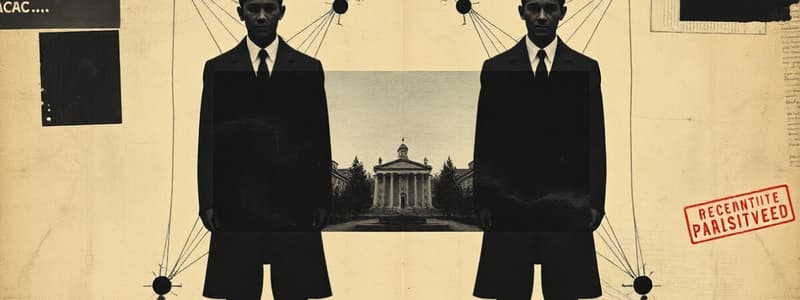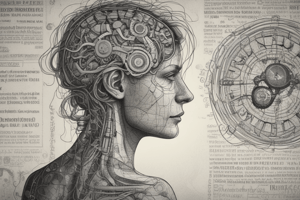Podcast
Questions and Answers
Match the following terms related to memory distortion with their correct descriptions:
Match the following terms related to memory distortion with their correct descriptions:
Misinformation Effect = Memory of an event is altered by misleading information encountered after the event. Source Monitoring Error = Misattributing the source of a memory, confusing where the memory originated. Weapon Focus Effect = Focusing on a weapon during a crime reduces recall of other details. Showup = Identification procedure with a higher risk of false identification due to suggestiveness.
Match the following conditions to whether eyewitness confidence is typically related or unrelated to identification accuracy:
Match the following conditions to whether eyewitness confidence is typically related or unrelated to identification accuracy:
Related = High quality viewing conditions Unrelated = Long delay between event and identification
Match each technique with its benefit for improving eyewitness accuracy:
Match each technique with its benefit for improving eyewitness accuracy:
Double-blind Lineups = Reduces unintentional bias from the administrator. Non-leading Instructions = Prevents suggestion that the suspect is definitely in the lineup. Cognitive Interviews = Reduces the likelihood of false memories. Sequential Lineups = Encourages absolute judgment rather than relative judgment.
Match each of the pristine conditions with its purpose in enhancing eyewitness identification accuracy:
Match each of the pristine conditions with its purpose in enhancing eyewitness identification accuracy:
Match the criteria from Manson v. Brathwaite with what they assess regarding eyewitness testimony:
Match the criteria from Manson v. Brathwaite with what they assess regarding eyewitness testimony:
Match the type of lineup with its characteristic:
Match the type of lineup with its characteristic:
Match the variables with their known impact on eyewitness accuracy:
Match the variables with their known impact on eyewitness accuracy:
Match the feedback type with its potential effect on eyewitness certainty:
Match the feedback type with its potential effect on eyewitness certainty:
Match the memory process with its vulnerability to distortion:
Match the memory process with its vulnerability to distortion:
Match each suggestion with its goal for improving eyewitness accuracy:
Match each suggestion with its goal for improving eyewitness accuracy:
Match each effect with its impact on eyewitness testimony:
Match each effect with its impact on eyewitness testimony:
Match the following lineup characteristics to how they improve eyewitness testimony:
Match the following lineup characteristics to how they improve eyewitness testimony:
Match the following procedures with their effects on eyewitness memory and identification:
Match the following procedures with their effects on eyewitness memory and identification:
Match the court admissibility criteria for eyewitness identification with their rationale:
Match the court admissibility criteria for eyewitness identification with their rationale:
Match each component of the Manson criteria with how it evaluates eyewitness reliability:
Match each component of the Manson criteria with how it evaluates eyewitness reliability:
Match the lineup practices with their intended improvement in identification accuracy:
Match the lineup practices with their intended improvement in identification accuracy:
Match the effect to how it influences an eyewitness recall or identification:
Match the effect to how it influences an eyewitness recall or identification:
Match the interview methods to its aim in enhancing testimony quality:
Match the interview methods to its aim in enhancing testimony quality:
Match the description from factors that can impact eyewitness memory:
Match the description from factors that can impact eyewitness memory:
Match court room testimony considerations with purpose in eyewitness accounts evaluations:
Match court room testimony considerations with purpose in eyewitness accounts evaluations:
Flashcards
Misinformation Effect
Misinformation Effect
Memory altered by misleading information after the fact.
Source Effect
Source Effect
Misattributing the source of a memory; remembering a fact but confusing its origin.
Weapon Focus Effect
Weapon Focus Effect
Witness focuses on a weapon during a crime, reducing recall of other details.
Lineups
Lineups
Signup and view all the flashcards
Showups
Showups
Signup and view all the flashcards
Eyewitness Accuracy
Eyewitness Accuracy
Signup and view all the flashcards
Unreliable Eyewitness ID
Unreliable Eyewitness ID
Signup and view all the flashcards
Improve Eyewitness Accuracy
Improve Eyewitness Accuracy
Signup and view all the flashcards
Pristine Conditions
Pristine Conditions
Signup and view all the flashcards
Manson Criteria
Manson Criteria
Signup and view all the flashcards
Study Notes
- A person's memory of an event can be altered by misleading information encountered after the event, which is known as the misinformation effect.
- The source effect occurs when a person misattributes the origin of a memory, recalling a fact but not its source.
- During a crime, if a witness focuses on a weapon, their ability to recall other details is reduced which exhibits the weapon focus effect.
Accuracy of Lineups vs. Showups
- Lineups, especially double-blind and sequential lineups, lead to more accurate identifications compared to showups.
- Showups carry a higher risk of false identification because of suggestiveness.
Relationship Between Eyewitness Confidence and Identification Accuracy
- Eyewitness confidence and accuracy are related during initial immediate identifications.
- High-quality viewing conditions and proper lineups also cause relations.
- Suggestive feedback can alter eyewitness confidence and accuracy.
- A long delay between the event and identification can also effect eyewitness confidence and accuracy.
- Poor viewing conditions also impact the relation of confidence and accuracy.
Improving Eyewitness Accuracy
- Double-blind lineups and sequential lineups can improve eyewitness accuracy.
- Avoiding confirming feedback and using non-leading instructions ensures accuracy.
- Accuracy is improved by Avoiding multiple identifications and utilizing cognitive interviews.
Pristine Conditions for Accurate Witness Identification
- Present only one suspect at a time in a lineup.
- Ensure the suspect does not stand out in the lineup.
- Provide unbiased instructions to the witness.
- Use a double-blind procedure.
- Obtain an immediate confidence statement from the witness.
Manson Criteria for Evaluating Eyewitness Testimony Accuracy (Manson vs. Braitwaite, 1977)
- The witness's opportunity to view the suspect is key.
- The witness's degree of attention is also important.
- The accuracy of the witness's prior description matters
- The witness's level of certainty is an important factor.
- The amount of time elapsed between the event and the identification is also important.
Studying That Suits You
Use AI to generate personalized quizzes and flashcards to suit your learning preferences.




